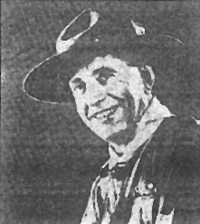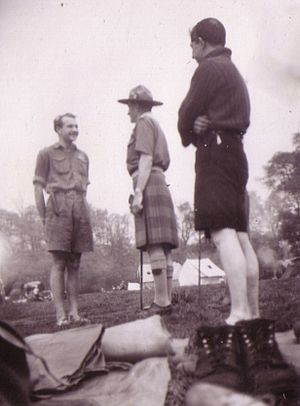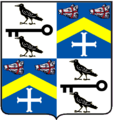Thomas Corbett, 2nd Baron Rowallan facts for kids
Quick facts for kids
The Lord Rowallan
|
|
|---|---|
 |
|
| 19th Governor of Tasmania | |
| In office 21 October 1959 – 25 March 1963 |
|
| Monarch | Elizabeth II |
| Premier | Eric Reece (1959–63) |
| Preceded by | Sir Ronald Cross |
| Succeeded by | Sir Charles Gairdner |
| Member of the House of Lords | |
| In office 19 March 1933 – 30 November 1977 Hereditary Peerage |
|
| Preceded by | Archibald Corbett |
| Succeeded by | Arthur Corbett |
| Personal details | |
| Born | 19 December 1895 Chelsea, London |
| Died | 30 November 1977 (aged 81) Rowallan Castle, Kilmarnock |
| Nationality | British |
| Spouse | Gwyn Mervyn Grimond |
| Civilian awards | Knight of the Order of the Thistle Knight Commander of the Order of the British Empire |
| Military service | |
| Allegiance | United Kingdom |
| Branch/service | British Army |
| Years of service | 1914–1918 1939–1944 |
| Rank | Lieutenant Colonel |
| Battles/wars | First World War
|
| Military awards | Military Cross Territorial Decoration |
Thomas Godfrey Polson Corbett (born December 19, 1895 – died November 30, 1977) was also known as the 2nd Baron Rowallan. He was a brave soldier in the British Army and later became the Governor of Tasmania from 1959 to 1963. He was also a very important leader for the Boy Scouts Association. He served as the Chief Scout for the British Commonwealth and Empire from 1945 to 1959, helping Scouting grow around the world.
Contents
Early Life & Family
Thomas Corbett was born in Chelsea, London, on December 19, 1895. His father was Archibald Corbett, a politician and property developer. His mother was Alice Mary. Thomas grew up in London and on his family's estates in Scotland.
He was known as "Billy" to his family. He went to schools like Gibbs School, Wellington House Preparatory School, and Eton College. Sadly, his mother passed away in 1902. His older sister, Elsie Cameron Corbett, became an ambulance driver during the First World War and received awards for her bravery. His younger brother, Arthur, died while serving in the military.
Marriage and Children
Thomas Corbett married Gwyn Mervyn Grimond on August 14, 1918. She was the sister of Jo Grimond, who later became a leader of the Liberal Party. They met when Thomas was home on leave from the war. They had five sons and one daughter.
After leaving the army, he became very good at raising special dairy cattle on his family's land in Ayrshire. He worked hard to get rid of a disease called bovine tuberculosis in cattle. He became the 2nd Baron Rowallan on March 19, 1933, after his father passed away.
Later Life and Passing
In 1961, while he was Governor of Tasmania, Lord Rowallan was diagnosed with cancer. He took time off to get treatment in London. He retired in 1963 and moved back to his family's estate in Scotland.
He wrote a book about his life called "Rowallan" when he was 80 years old. Lord Rowallan passed away at Rowallan Castle, near Kilmarnock, on November 30, 1977. His daughter and four of his sons survived him. One of his sons, John, had died in battle in 1944.
Military Service
Thomas Corbett had an impressive career in the military, serving in both World Wars.
World War I Heroism
When the First World War started, Corbett was 18 years old. He joined the Ayrshire Yeomanry and went to Gallipoli in October 1915. His unit was among the last to leave Gallipoli and then moved to Egypt. They were part of the cavalry in the Second Battle of Gaza.
Later, he joined the Grenadier Guards and was sent to the Western Front in March 1918. This was during a major German attack called Operation Michael. On March 30, 1918, at Boyelles, Corbett bravely tried to rescue wounded soldiers who were buried by explosions. He did this "under heavy fire and in full view of the enemy." For his courage, he received the Military Cross. He was also wounded in the leg, which caused a permanent injury.
World War II Contributions
Between the two World Wars, Corbett served as an Adjutant for the Ayrshire Yeomanry. In 1939, he formed a new battalion of the Royal Scots Fusiliers for the Territorial Army. He went with them to France as part of the British Expeditionary Force.
He was evacuated from Cherbourg during Operation Aerial. After that, he led a Young Soldiers’ Battalion in the Scottish Highlands. He started adventurous training for them, inspired by his long connection with the Scout Movement. His success led him to become the leader of the new Highland Fieldcraft Training Centre. This center helped young officers learn leadership skills. His methods were so good that a "Rowallan Company" was formed at Royal Military Academy Sandhurst in 1977 to use his ideas to train future officers.
Governor of Tasmania
Lord Rowallan became the Governor of Tasmania on October 21, 1959. Even though some people wanted an Australian to be the next Governor, he took on the role. He worked hard to promote Tasmania and protect its interests. The Rowallan Power Station, along with its dam and lake, are named after him.
In his free time, he raised a group of Jersey cattle at Government House. He also sailed a yacht, which he later gave to the local Sea Scouts. After his illness in 1961, his time as Governor ended on March 25, 1963.
Chief Scout of the Commonwealth
Lord Rowallan had a very important role in the Boy Scouts Association.
Early Scouting Leadership
He became a district commissioner for Scouting in north-west Ayrshire in 1922. In 1944, he was put in charge of leader training for the Boy Scouts Association in Scotland.
Becoming Chief Scout
In 1945, the Boy Scouts Association chose him as its Chief Scout for the United Kingdom and its territories. In April of the same year, he became the Chief Scout of the British Commonwealth and Empire. He held these important positions until 1959. He also served on the World Scout Committee from 1947 to 1953.

Traveling the World for Scouting
As Chief Scout, Lord Rowallan traveled a lot to encourage Scouting after World War II. His trips included:
- Belgium (1945)
- Canada (1946, 1958)
- West Africa, including a Jamboree (1947)
- United States of America (1948)
- Australia and New Zealand (1948–49, 1955–56)
- Southern Africa (1950)
- East Africa (1950)
- Caribbean Islands (1952)
- Mediterranean and Europe (1954)
- Scandinavia (1954)
- Southeast Asia (1954)
- Papua New Guinea, Fiji, Tonga, and the Solomon Islands (1955–56)
- Central African Jamboree (1959)
Scouting Awards and Recognition
In 1957, the World Scout Committee gave Lord Rowallan its highest honor, the Bronze Wolf, for his amazing service to world Scouting. The Boy Scouts of America also gave him their top award, the Silver Buffalo Award, in 1948.
Some Scout campsites are named after him, like those in Riddells Creek in Victoria and Wrexham in Wales. The Kenya Scouts Association Headquarters Campsite in Nairobi is also named in his honor.
Other Achievements
Lord Rowallan received several other important awards and recognitions:
- He became a Knight of the Order of the Thistle in March 1957. This is a very high honor in Scotland.
- He was given the Freedom of the City of Edinburgh in March 1957.
- In 1954, a special train engine (No. 70045) was named in his honor.
Images for kids



